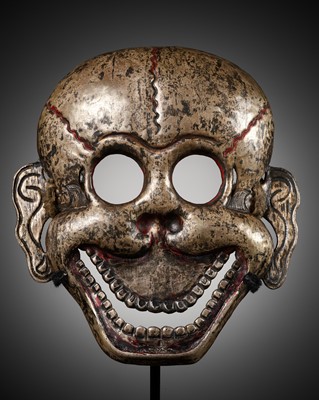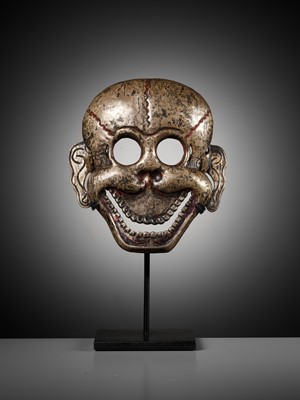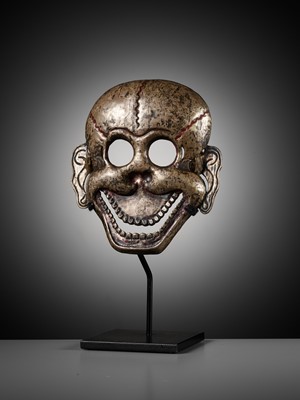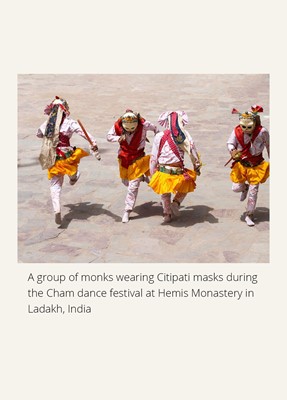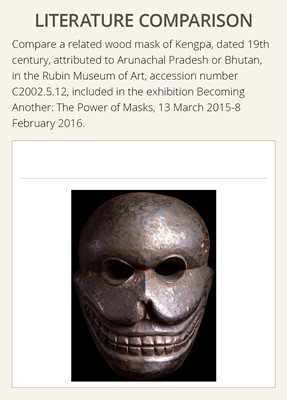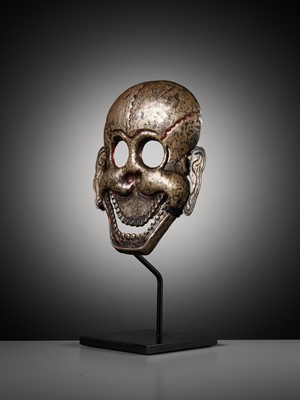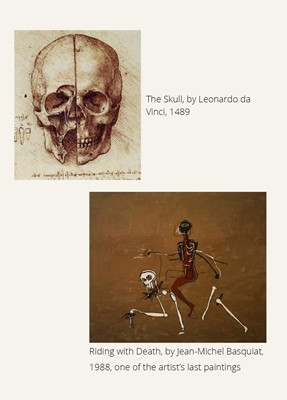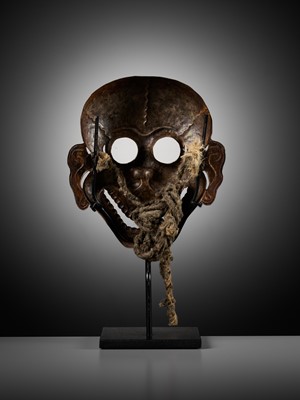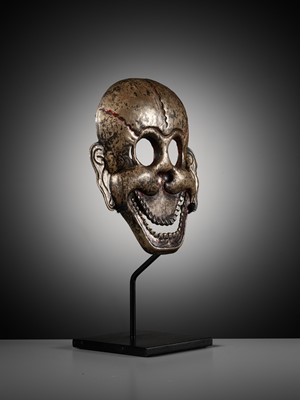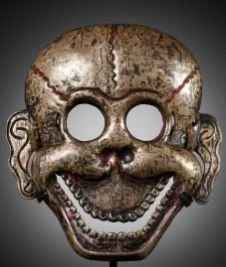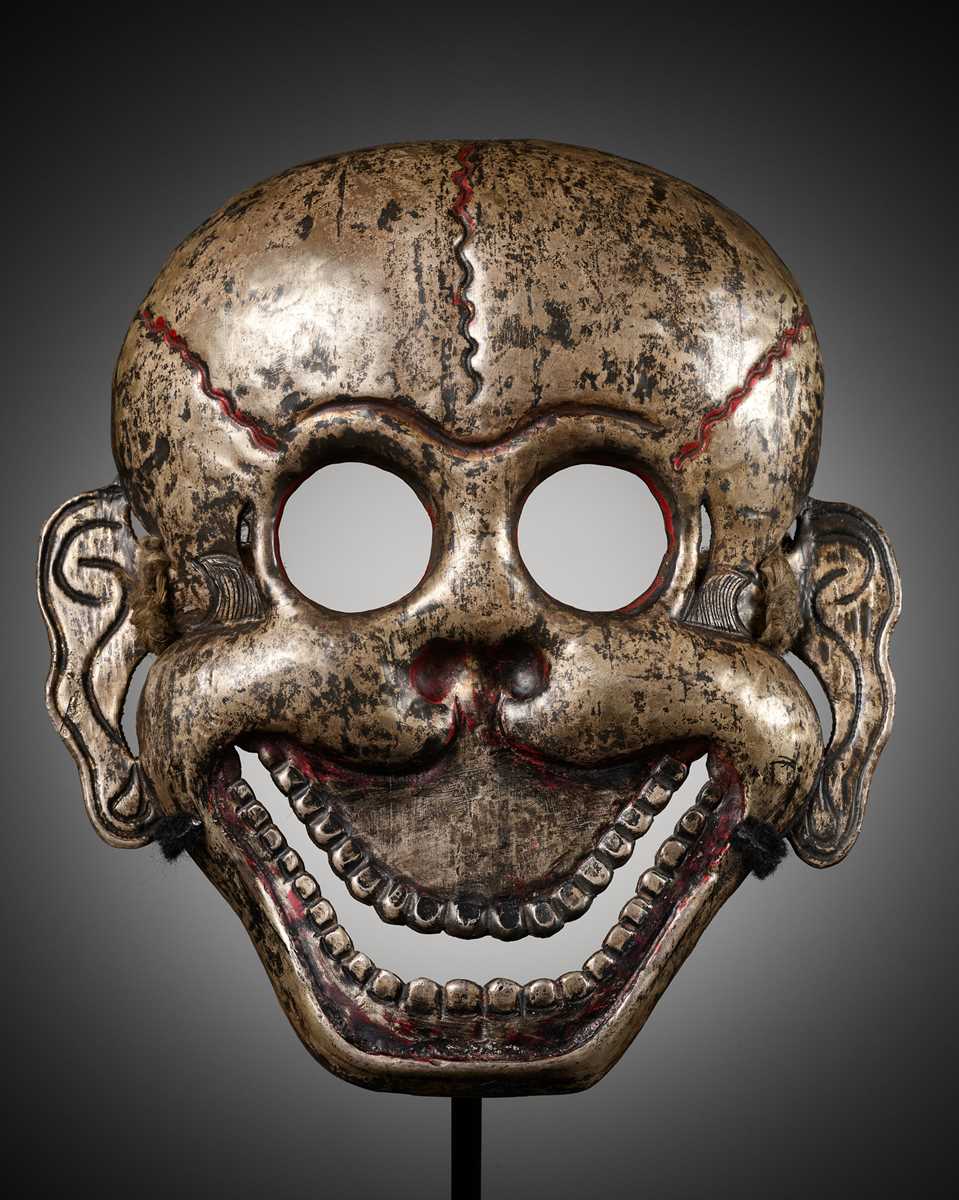11th Apr, 2024 11:00
TWO-DAY AUCTION: Fine Asian Art, Buddhism and Hinduism
2
A SILVER REPOUSSÉ MASK OF A CHITIPATI, TIBET, 18TH-19TH CENTURY
Sold for €7,800
including Buyer's Premium
Well modeled as a skull with large circular openings for the eyes, impressed nose, and a grotesque smile revealing a set of square teeth, flanked by neatly incised ears, the forehead with wavy lines imitating the sutures of the skull. Remnants of ritual painting.
Provenance: A private collection in the United States, early 2000s. Property of a Gentleman, acquired from the above.
Condition: Very good condition with expected extensive wear from within the culture, small dents, few nicks, light scratches, manufacturing flaws, remnants of pigment, expected tarnishing to silver. Naturally grown dark patina. The backside with fragments of ancient cords for attachment.
Weight: 241 g (excl. stand)
Dimensions: Height 20.5 cm (excl. stand)
Mounted to a modern stand. (2)
The wrathful appearance of Chitipati masks can be likened to a momento mori, acting as a reminder of death and the impermanence and emptiness of all things. These skeleton masks were worn during Tibetan ritual dance ceremonies throughout the Himalayas and Mongoli, and even today are traditionally worn during Cham ritual dances, sacred theatrical practices performed as narrative guides to Buddhist teachings. The masks themselves are meant to transform dancers into gods, in a visual display of Buddhist rituals. Chitipati, specifically, as ‘lord of the charnel ground’, are considered retinue figures to other deities.
Chitipati are a divine skeleton couple also and initially known as Shri Shmashana Adhipati, "the lord and lady of the charnel ground." They act as protector deities, particularly against thieves and grave robbers, vowing to destroy enemies of the Dharma. They are closely associated with the Chakrasamvara Tantra and visually represented as intertwined jovial skeletal figures, each holding various attributes, dancing in a halo of wild flames. Their wrathful and skeletal appearance can be likened to a momento mori, acting as a reminder of death and the temporality of all things. As macabre lords of the cremation grounds, they serve to remind Tibetans of the inevitability of death and decay, while at the same time, to celebrate one's ultimate liberation from duality. A much beloved subject in Tibetan Buddhism, the Chitipati are represented on thangkas and appliques, in sculpture, on wooden shrines and furniture, and as elaborate costumes worn during ceremonial dances (Cham), in a visual type that becomes standardized for centuries.
Memento mori (Latin for 'remember that you die') is an artistic or symbolic trope acting as a reminder of the inevitability of death. The concept has its roots in the philosophers of classical antiquity and appeared in art and architecture from the medieval period onwards. The most common motif is a skull, often accompanied by one or more bones, or a complete skeleton. Often this alone is enough to evoke the trope, but sometimes other motifs such as a coffin, hourglass and wilting flowers were added to signify the impermanence of human life.
From Leonardo to Basquiat, the most important artists of the modern world were fascinated by the Memento Mori trope. Likewise, the Chitipati are a reminder of the eternal cycle of life and death. Furthermore, there is a mind training practice in Tibetan Buddhism known as Lojong, the 'Four Contemplations to Cause a Revolution in the Mind'. The second of these four is the contemplation of impermanence and death. In particular, one contemplates that:
All compounded things are impermanent,
The human body is a compounded thing,
Therefore, death of the body is certain,
The time of death is uncertain and beyond our control.
There are a number of classic verse formulations of these contemplations meant for daily reflection to overcome our strong habitual tendency to live as though we will certainly not die today.
Literature comparison:
Compare a related wood mask of Kengpa, dated 19th century, attributed to Arunachal Pradesh or Bhutan, in the Rubin Museum of Art, accession number C2002.5.12, included in the exhibition Becoming Another: The Power of Masks, 13 March 2015-8 February 2016.
Well modeled as a skull with large circular openings for the eyes, impressed nose, and a grotesque smile revealing a set of square teeth, flanked by neatly incised ears, the forehead with wavy lines imitating the sutures of the skull. Remnants of ritual painting.
Provenance: A private collection in the United States, early 2000s. Property of a Gentleman, acquired from the above.
Condition: Very good condition with expected extensive wear from within the culture, small dents, few nicks, light scratches, manufacturing flaws, remnants of pigment, expected tarnishing to silver. Naturally grown dark patina. The backside with fragments of ancient cords for attachment.
Weight: 241 g (excl. stand)
Dimensions: Height 20.5 cm (excl. stand)
Mounted to a modern stand. (2)
The wrathful appearance of Chitipati masks can be likened to a momento mori, acting as a reminder of death and the impermanence and emptiness of all things. These skeleton masks were worn during Tibetan ritual dance ceremonies throughout the Himalayas and Mongoli, and even today are traditionally worn during Cham ritual dances, sacred theatrical practices performed as narrative guides to Buddhist teachings. The masks themselves are meant to transform dancers into gods, in a visual display of Buddhist rituals. Chitipati, specifically, as ‘lord of the charnel ground’, are considered retinue figures to other deities.
Chitipati are a divine skeleton couple also and initially known as Shri Shmashana Adhipati, "the lord and lady of the charnel ground." They act as protector deities, particularly against thieves and grave robbers, vowing to destroy enemies of the Dharma. They are closely associated with the Chakrasamvara Tantra and visually represented as intertwined jovial skeletal figures, each holding various attributes, dancing in a halo of wild flames. Their wrathful and skeletal appearance can be likened to a momento mori, acting as a reminder of death and the temporality of all things. As macabre lords of the cremation grounds, they serve to remind Tibetans of the inevitability of death and decay, while at the same time, to celebrate one's ultimate liberation from duality. A much beloved subject in Tibetan Buddhism, the Chitipati are represented on thangkas and appliques, in sculpture, on wooden shrines and furniture, and as elaborate costumes worn during ceremonial dances (Cham), in a visual type that becomes standardized for centuries.
Memento mori (Latin for 'remember that you die') is an artistic or symbolic trope acting as a reminder of the inevitability of death. The concept has its roots in the philosophers of classical antiquity and appeared in art and architecture from the medieval period onwards. The most common motif is a skull, often accompanied by one or more bones, or a complete skeleton. Often this alone is enough to evoke the trope, but sometimes other motifs such as a coffin, hourglass and wilting flowers were added to signify the impermanence of human life.
From Leonardo to Basquiat, the most important artists of the modern world were fascinated by the Memento Mori trope. Likewise, the Chitipati are a reminder of the eternal cycle of life and death. Furthermore, there is a mind training practice in Tibetan Buddhism known as Lojong, the 'Four Contemplations to Cause a Revolution in the Mind'. The second of these four is the contemplation of impermanence and death. In particular, one contemplates that:
All compounded things are impermanent,
The human body is a compounded thing,
Therefore, death of the body is certain,
The time of death is uncertain and beyond our control.
There are a number of classic verse formulations of these contemplations meant for daily reflection to overcome our strong habitual tendency to live as though we will certainly not die today.
Literature comparison:
Compare a related wood mask of Kengpa, dated 19th century, attributed to Arunachal Pradesh or Bhutan, in the Rubin Museum of Art, accession number C2002.5.12, included in the exhibition Becoming Another: The Power of Masks, 13 March 2015-8 February 2016.
Zacke Live Online Bidding
Our online bidding platform makes it easier than ever to bid in our auctions! When you bid through our website, you can take advantage of our premium buyer's terms without incurring any additional online bidding surcharges.
To bid live online, you'll need to create an online account. Once your account is created and your identity is verified, you can register to bid in an auction up to 12 hours before the auction begins.
Intended Spend and Bid Limits
When you register to bid in an online auction, you will need to share your intended maximum spending budget for the auction. We will then review your intended spend and set a bid limit for you. Once you have pre-registered for a live online auction, you can see your intended spend and bid limit by going to 'Account Settings' and clicking on 'Live Bidding Registrations'.
Your bid limit will be the maximum amount you can bid during the auction. Your bid limit is for the hammer price and is not affected by the buyer’s premium and VAT. For example, if you have a bid limit of €1,000 and place two winning bids for €300 and €200, then you will only be able to bid €500 for the rest of the auction. If you try to place a bid that is higher than €500, you will not be able to do so.
Online Absentee and Telephone Bids
You can now leave absentee and telephone bids on our website!
Absentee Bidding
Once you've created an account and your identity is verified, you can leave your absentee bid directly on the lot page. We will contact you when your bids have been confirmed.
Telephone Bidding
Once you've created an account and your identity is verified, you can leave telephone bids online. We will contact you when your bids have been confirmed.
Classic Absentee and Telephone Bidding Form
You can still submit absentee and telephone bids by email or fax if you prefer. Simply fill out the Absentee Bidding/Telephone bidding form and return it to us by email at office@zacke.at or by fax at +43 (1) 532 04 52 20. You can download the PDF from our Upcoming Auctions page.
How-To Guides
How to Create Your Personal Zacke Account
How to Register to Bid on Zacke Live
How to Leave Absentee Bids Online
How to Leave Telephone Bids Online
中文版本的操作指南
创建新账号
注册Zacke Live在线直播竞拍(免平台费)
缺席投标和电话投标
Third-Party Bidding
We partner with best-in-class third-party partners to make it easy for you to bid online in the channel of your choice. Please note that if you bid with one of our third-party online partners, then there will be a live bidding surcharge on top of your final purchase price. You can find all of our fees here. Here's a full list of our third-party partners:
- 51 Bid Live
- EpaiLive
- ArtFoxLive
- Invaluable
- LiveAuctioneers
- the-saleroom
- lot-tissimo
- Drouot
Please note that we place different auctions on different platforms. For example, in general, we only place Chinese art auctions on 51 Bid Live.
Bidding in Person
You must register to bid in person and will be assigned a paddle at the auction. Please contact us at office@zacke.at or +43 (1) 532 04 52 for the latest local health and safety guidelines.
